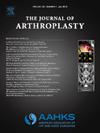无症状炎症标记物升高:原发性全膝关节置换术有感染或翻修风险吗?
IF 3.4
2区 医学
Q1 ORTHOPEDICS
引用次数: 0
摘要
背景:全膝关节置换术(TKA)是晚期膝关节骨性关节炎的首选治疗方法。长期研究报告显示,患者满意度很高,而假体周围关节感染(PJI)等并发症则可能造成严重后果。了解 PJI 的风险因素对于最大限度地减少并避免并发症至关重要。本研究的目的是调查初级 TKA 术前无症状 C 反应蛋白(CRP)和红细胞沉降率(ESR)水平较高的患者发生 PJI 和翻修的风险:2010年至2022年期间接受初次TKA手术的患者均符合条件。纳入标准为术前生化指标完整且随访至少 12 个月的患者。排除第一年内死亡的患者,以及有炎症性关节炎、自身免疫性疾病、肾脏病变或化脓性关节炎病史的患者。对手术前 48 小时内血液 CRP 和 ESR 水平升高的患者进行了全面体检,重点是感染症状。经过筛查和咨询,残留的 CRP 和 ESR 水平升高被归类为无症状。经排除后,共纳入了 1528 名患者。平均年龄为 66 岁(35 至 92 岁不等),平均随访时间为 6.4 年(1.6 至 12.3 年不等):术后一年内的翻修率为 1.6%,而前五年的翻修率为 3.8%。术后第1年和第5年的PJI率分别为1.7%和2.9%。回归分析并未显示任何潜在变量是导致翻修或PJI的风险因素:结论:无症状的急性期反应物升高不是假体周围感染或无菌翻修的风险因素。在平均6.4年的随访中,总存活率为96.7%,只有2.2%的患者因PJI而翻修。本文章由计算机程序翻译,如有差异,请以英文原文为准。
Asymptomatic Elevated Inflammatory Markers: Is There a Risk for Infection or Revision in Primary Total Knee Arthroplasty?
Background
Total knee arthroplasty (TKA) is the treatment of choice for advanced knee osteoarthritis. Long-term studies report high patient satisfaction, while complications such as periprosthetic joint infection (PJI) can be devastating. Knowledge regarding risk factors for PJI is critical to minimize and ideally avoid complications. The purpose of this study was to investigate the risk of PJI and revision in patients who had preoperative asymptomatic high C-reactive protein (CRP) and erythrocyte sedimentation rate (ESR) levels in primary TKAs.
Methods
Patients undergoing primary TKA between 2010 and 2022 were eligible. Inclusion criteria were patients who had preoperative complete biochemical parameters and a minimum follow-up of 12 months. Patients who died during the first year, and those who had a history of inflammatory arthritis, autoimmune disease, renal pathologies, or septic arthritis, were excluded. Patients who had elevated blood CRP and ESR levels taken within 48 hours before surgery underwent a thorough medical examination with a focus on infection symptoms. After screening and consultation, residual elevated CRP and ESR levels were classified as asymptomatic. After exclusions, 1,528 patients were included. The mean age was 66 years (range, 35 to 92), and the mean follow-up time was 6.4 years (range, 1.6 to 12.3).
Results
The rate of revision within one year after surgery was 1.6%, whereas the rate of revision in the first 5 years was 3.8%. The PJI rates for the 1st and 5th postoperative years were 1.7 and 2.9%, respectively. Regression analysis did not show any of the potential variables to be a risk factor for revision or PJI.
Conclusions
Asymptomatic elevated acute-phase reactants are not a risk factor for periprosthetic joint infection or aseptic revision. At a mean follow-up of 6.4 years, overall survival was 96.7%, with only 2.2% of patients revised due to a PJI.
求助全文
通过发布文献求助,成功后即可免费获取论文全文。
去求助
来源期刊

Journal of Arthroplasty
医学-整形外科
CiteScore
7.00
自引率
20.00%
发文量
734
审稿时长
48 days
期刊介绍:
The Journal of Arthroplasty brings together the clinical and scientific foundations for joint replacement. This peer-reviewed journal publishes original research and manuscripts of the highest quality from all areas relating to joint replacement or the treatment of its complications, including those dealing with clinical series and experience, prosthetic design, biomechanics, biomaterials, metallurgy, biologic response to arthroplasty materials in vivo and in vitro.
 求助内容:
求助内容: 应助结果提醒方式:
应助结果提醒方式:


